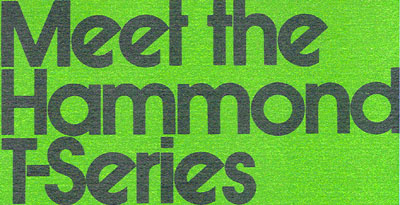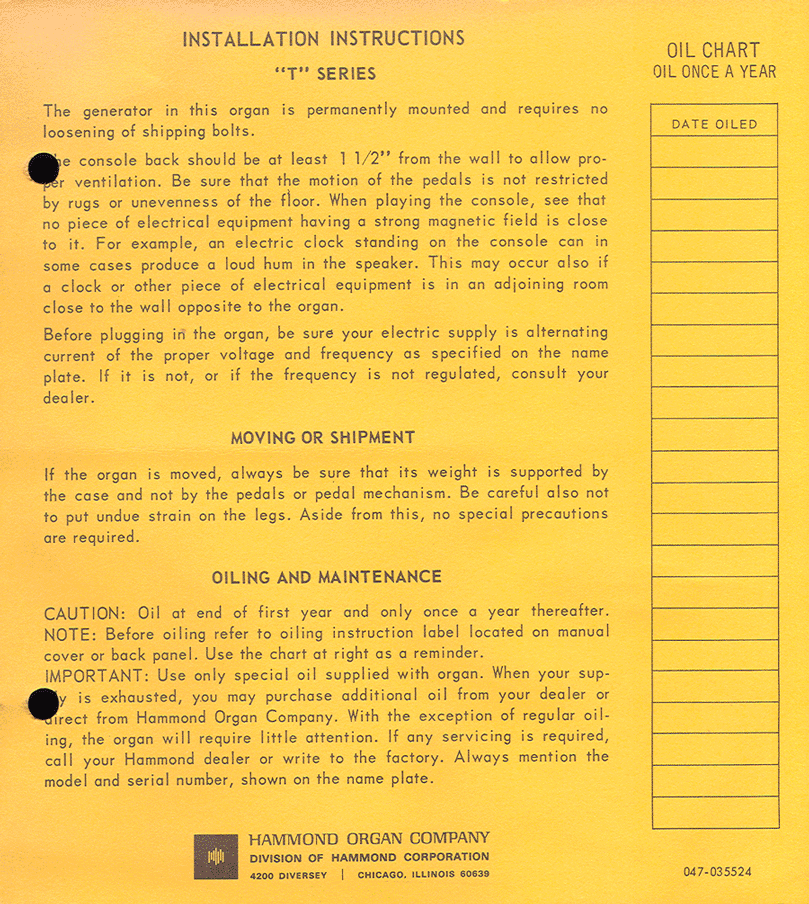

| This series of tonewheel
Hammonds is perhaps not so sought after anymore. Nevertheless they were made
in many different models and in big numbers back when organs had
electro-magnetic generators. The T-series was the very last tonewheel spinet
series to be introduced, and its last incarnation, the T-500 series,
was the last tonewheel series ever to see the light of day. The T-series
could be called a solid state M-100 or maybe an L-100 with scanner vibrato
and was introduced in early 1968. The T-spinet may not sound as 'fat' as the M-series but many prefer the T over the L-100, especially because of the scanner vibrato. Even if the T is all solid state in the amplifier circuits it has the genuine tonewheel generator and, as previously mentioned, the Hammond scanner vibrato (and vibrato/chorus). A T-series Hammond, when working properly, will give you many features and an overall big sound from a small instrument. This is especially true for the T-500 series. |
| First, a picture of the first two models in the T-series T-100 and T-200, taken from a Danish sales brochure, kindly scanned and supplied to me by Hans Wehner. |
|
Click here for a translation of the Danish text. I have tried to keep the wording, peculiar as it is, maybe because it was at one time translated from English to German and then Danish.
Below, the technical specs for the two models. They are identical with the exception of the built-in Leslie in the T-200.
Click here for translation.
Here is a scan of an original oiling chart with installation instructions from a T-200 organ. If your T-organ doesn't have one, you could print out a copy for it :o) Thanks to Don in New Jersey for this piece.

Different versions of the T-series
The T-series organs came in various models and styles. Below is a rough break-down of the different T-series types.
| Series | Key features | Built-in Leslie | Tone cabinet interface | Notes |
| T-100 | Basic organ, simple brush/cymbal effect | No |
Series 10 (7-pin) |
Early organs had the flat 'pie' scanner as found in other Hammond organs. Later organs had the 'drum' scanner (see T-400 pictures on the next page) |
| T-200 | As above but with built-in Leslie | Yes | ||
| T-262 | Institutional version of the T-200. Equipped with a locking top, light over the control tabs and a slightly different percussion section (see notes). No scanner vibrato. | Yes | The following percussion stops/features were omitted in this model: Marimba, Xylophone, Banjo, Brush, Cymbal, Guitar and reiterate. Also, the vibrato scanner and related circuitry is not present. Presets and percussion stops are tailored to liturgical music styles. End block control tab functions relocated to the flip tabs above the keyboards. | |
| T-200-1 | Same as T-200 but with the simple brush/cymbal effect replaced by a 6-voice rhythm board. | Yes | In Europe, this model was named TR-200 (and TR-100 without the built-in Leslie). A special variant without Leslie, in an open bottom style cabinet was named TTR-100 (see next page) | |
| T-200-2 | Same as T-200 but with added Rhythm II 'drawer' device installed from the factory. | Yes | The brush/cymbal effect was incorporated in the 6-voice rhythm board. | |
| T-300 | Brush/cymbal effects replaced by 'Rhythm Rail' | Yes | The Hammond Rhythm Rail had 10 voices and an auto- accompaniment feature (tied to the lower manual buss amplifier). | |
| T-400 | Added Hammond Rhythm II drum machine | Yes | ||
| XTP | Special cabinet with a single chrome pedestal supporting the upper part of the console. | No (see note) | Leslie 9-pin (model 700 or 710) | Electrically similar to a T-400 but with some features that would later be incorporated in the T-500 series - such as split vibrato and a stock Leslie socket. A set of small tone cabinets (one regular speaker and one special Leslie-like speaker) was part of the package. Click here to see a catalogue page showing it. |
| T-500 | Major design change for many circuits. New features included Hammond Rhythm III drum machine, coloured tabs, 'Leslie Chorus' effect and split vibrato. Could be ordered with a built-in cassette deck. | Yes | Some models came with a cassette deck. Hammond in Denmark/Germany made a variant called TX-500 with a cabinet like the X-77 console (this one had no Leslie of course) |
Cabinet styles
Like all other Hammond organs of the X-YZZ model type, where the X is the model family, Y is the sub-type (if applicable, otherwise this is just a '1') and ZZ is the cabinet style, the different T-series had several cabinet styles offered - some were only made in the US, some only outside of the US. Common variants include '11' and '12' for Traditional Walnut and Oak respectively, '33' for French Provincial (e.g. T-233), '43' for Early American and '82' for Mediterranean. T-500 organs fitted with a cassette deck had a 'c' added to the model designation (e.g. T-524c). The number system was not completely consistent between the different model families, although the '62' designation was used for institutional models like the T-262, M-162 and E-262. Click here for a page out of a 1971 Hammond catalogue showing different styles of the T-series organs.